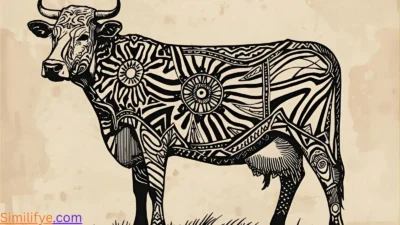One quiet morning, I walked outside and saw a butterfly land gently on a flower in my garden.
Its wings glowed in the early sunlight, and for a moment, time seemed to pause.
I wondered—was this just a simple scene of nature, or was life whispering a message to me?
That moment led me down the path of understanding types of symbolism—the hidden meanings behind images, encounters, and stories.
Symbolism has been used for centuries by poets, artists, and spiritual seekers to connect the visible world with the unseen.
Every bird, color, dream, or even chance encounter can hold a deeper spiritual and emotional meaning.
In this article, we’ll explore the different types of symbolism, how they appear in literature, art, and life, and how you can recognize them in your own journey.
Different Types of Symbolism

Symbolism is the language of the soul—it allows us to communicate feelings and truths that words alone cannot capture. There are many different types of symbolism, and each brings its own way of revealing hidden layers of meaning:
- Animal Symbolism: Animals often carry spiritual messages. A lion can mean courage, while a dove might mean peace.
- Color Symbolism: Colors evoke emotions—red for passion, blue for calm, gold for wisdom.
- Nature Symbolism: Trees, rivers, mountains, and skies reflect growth, change, or eternity.
- Object Symbolism: A key may symbolize freedom or opportunity; a candle may symbolize hope.
- Number Symbolism: Numbers like 3, 7, or 11 often represent spiritual truths and cycles.
- Cultural Symbolism: Different cultures attach unique meanings to animals, shapes, and objects.
When you pay attention, everyday life becomes alive with messages, guidance, and emotional depth.
Types of Symbolism in Literature
Writers use symbolism to weave layers of meaning into their stories. Instead of saying something directly, they let symbols create emotional depth. Some examples:
- Allegorical Symbolism: An entire story represents a bigger idea—like George Orwell’s Animal Farm, symbolizing political power.
- Religious Symbolism: References to crosses, light, or rebirth add spiritual weight.
- Natural Symbolism: Seasons often symbolize life cycles—spring for birth, winter for endings.
- Animal Symbolism in Stories: A raven may symbolize mystery or death, while a lamb symbolizes innocence.
- Dream Symbolism: Characters’ dreams reveal fears or hidden truths.
Through types of symbolism in literature, readers feel emotions that go beyond the page—hope, loss, longing, or courage.
Types of Symbolism in Writing

Symbolism in writing isn’t just for novels—it appears in poems, letters, and even personal journaling. Writers use symbols to:
- Express emotions without naming them directly (a storm for anger).
- Foreshadow events (a broken mirror for bad luck ahead).
- Reveal character traits (a crown for pride).
- Offer spiritual meaning (a candle flame for faith).
Whether you’re journaling about a bird you saw or reading a poem about a river, these types of symbolism in writing help you connect with deeper truths.
Types of Symbolism in Art

Art transforms emotions into images. Painters, sculptors, and designers all use symbolism in art to communicate what words cannot:
- Religious Icons: Halos symbolize holiness, while fire may symbolize the divine spirit.
- Colors in Art: Black may show grief, white may show purity.
- Shapes and Patterns: Circles symbolize unity, triangles may symbolize balance or spiritual trinity.
- Animal Figures: Owls for wisdom, serpents for transformation.
- Abstract Symbolism: Artists like Picasso used shapes and colors to express emotions like chaos or peace.
Art allows us to feel a spiritual vibration through symbols without needing explanation.
Different Types of Symbolism in Literature
When looking deeper, we can identify some specific different types of symbolism in literature:
- Conventional Symbolism: Symbols that most readers recognize, like the heart for love.
- Contextual Symbolism: Symbols that only work within the story—like a personal object.
- Universal Symbolism: Shared across cultures, like the sun symbolizing life.
- Personal Symbolism: Created by the author’s own imagination.
By recognizing these, readers open doors to emotional and spiritual insight within stories.
What Are the Types of Symbolism?
If someone asks, what are the types of symbolism?, the simplest way to answer is:
- Literal Symbolism: Something tangible that represents an idea (a ring = eternity).
- Abstract Symbolism: Concepts like freedom, fear, or hope shown through imagery.
- Cultural Symbolism: Meanings tied to traditions, myths, and history.
This shows us that symbols are not random—they are bridges between reality and meaning.
Types of Symbolism in Media

From movies to songs, types of symbolism in media surround us every day:
- Film Symbolism: A sunset may symbolize closure, while rain might symbolize sadness.
- Music Symbolism: Instruments, lyrics, and rhythms often carry spiritual meanings.
- Advertising Symbolism: Companies use animals, colors, or shapes to influence feelings.
- Television Symbolism: Popular shows use objects (like thrones or swords) to carry meaning.
Once you notice, you’ll never watch a movie or listen to music the same way again.
What Are the Different Types of Symbolism?
People often wonder, what are the different types of symbolism? The main ones include:
- Animal Symbolism
- Color Symbolism
- Nature Symbolism
- Object Symbolism
- Religious Symbolism
- Cultural Symbolism
- Number Symbolism
Each of these opens a new door to emotional awareness and spiritual reflection.
Three Types of Symbolism

Some teachings simplify symbolism into three main categories:
- Religious Symbolism – Connecting us to the divine and sacred.
- Emotional Symbolism – Expressing human feelings like love, grief, or joy.
- Natural Symbolism – Drawing meaning from the earth, animals, and sky.
These three types of symbolism remind us that symbols are mirrors of the human soul.
Real-Life Scenarios of Symbolism
Here are three short real-life scenarios where symbolism brings deeper meaning:
- A White Feather: A woman grieving her father finds a white feather on her windowsill. To her, it symbolizes his presence and peace.
- A Storm Clearing: After a hard year, a man sees a rainbow appear after heavy rain. He feels it symbolizes hope and renewal.
- A Visiting Owl: A family hears an owl hoot at night. They take it as a symbol of wisdom and guidance through tough decisions.
These show how symbolism touches daily life with comfort, hope, and insight.
FAQs
1. Why is symbolism important in spirituality?
Symbolism helps us see everyday events as spiritual signs, guiding us toward growth and emotional healing.
2. Can animals really carry symbolic meaning?
Yes, throughout history animals have been messengers of spiritual truths—like butterflies for transformation or wolves for loyalty.
3. Are symbols the same in every culture?
Not always. Some are universal, while others change across cultures and traditions.
4. How can I recognize symbolism in my own life?
Pay attention to repeated encounters, dreams, and emotional responses. If something touches your heart deeply, it may be symbolic.
5. Can symbolism change meaning over time?
Yes. A symbol’s meaning may evolve as your spiritual journey grows and life experiences deepen.
Conclusion
Symbolism is more than words—it’s the heartbeat of our stories, dreams, and spiritual encounters.
From literature and art to the quiet moments in our own lives, symbols remind us that we are connected to something greater.
The next time you notice a bird outside your window, a certain number appearing again and again, or even a dream that lingers in your mind—pause.
Life may be sending you a symbol of comfort, guidance, or renewal.
When we honor the different types of symbolism, we learn to see with more than just our eyes—we learn to feel with our hearts.



